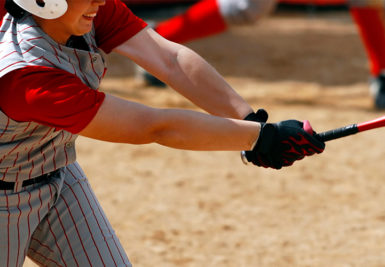A rotator cuff tear is a common injury, especially in adults over 40 and athletes who use their arms a lot, like baseball pitchers, tennis players and swimmers. When your rotator cuff tear is coupled with shoulder arthritis, you may be a candidate for a reverse shoulder replacement.
Read on to hear from OrthoIndy shoulder surgeon Dr. Jeffery Soldatis on common shoulder pain causes. He explains when he recommends reverse shoulder replacements, what surgery risks are, and what the recovery process looks like.
Why would you need a reverse shoulder replacement?
“Reverse shoulder replacement is done in the case of severe rotator cuff failure, (rotator cuff arthropathy) or severe arthritic deformity of the shoulder, where an anatomic shoulder replacement will not fit well,” says Dr. Soldatis.
Instead of relying on the rotator cuff to power your arm’s range of motion and movement, a reverse shoulder replacement reassigns those functions to the deltoid muscle.
The deltoid muscle is the largest and strongest muscle in your shoulder. Tendons attach it to the clavicle and humerus, and its normal function is to provide you the strength to lift your arm.
What is the difference between a shoulder replacement and a reverse shoulder replacement?
A total shoulder replacement is only considered necessary when arthritis has worn all the cartilage between your bones away and your rotator cuff is still intact.
However, suppose you also have a torn rotator cuff. In that case, the plastic socket implant placed on your shoulder blade is likely to loosen because there is no rotator cuff to keep the metal ball (replacing the humeral head) in place, making the joint move abnormally.
“A reverse shoulder replacement ‘reverses’ the mechanics of the regular anatomy of the shoulder,” says Dr. Soldatis.
“A standard shoulder replacement or anatomic shoulder replacement just exchanges an anatomic replica of the shoulder joint. In a reverse shoulder replacement, the place of the ball and the socket are switched or ‘reversed’ to function differently mechanically.”
Two joints make up the shoulder:
- The acromioclavicular joint connects your shoulder blade to your collarbone and allows you to raise your arm above your head.
- The glenohumeral joint is a ball and socket joint. It gives you the ability to rotate your shoulder in a circle and move it up and out from your body.
Soft tissue like ligaments, cartilage and tendons surround your glenohumeral joint. They help cushion the joint’s movement and keep the large humeral head in the shallow socket cavity.
Your rotator cuff is a group of tendons and muscles surrounding the top of the humerus to keep the head in place and allow your arm to rotate.
When the rotator cuff is torn, the tendons can’t keep the humeral head in the socket and your arm won’t rotate properly. So instead of placing a plastic socket on your scapula, a ball is attached and a plastic “cup” is placed at the end of your humerus where your humeral head was previously.
This reverses the mechanics of how a normal shoulder would operate.
Make an appointment with a shoulder specialist
How long does it take to recover from total shoulder replacement?
“Recovery for a total shoulder replacement is the same whether anatomic shoulder replacement or reverse shoulder replacement,” says Dr. Soldatis.
“Patients are usually in a sling for six weeks which is followed by another six weeks of physical therapy (after which point function is about 70%). It takes another full two months or so before you will feel about 90 to 100% recovered and get back your strength and confidence,” says Dr. Soldatis.
Learn more about OrthoIndy shoulder treatments
What are the risks of reverse shoulder replacement surgery?
“Risks include infection, blood clot and nerve injury,” says Dr. Soldatis. “However, these are pretty low as we have been performing total shoulder replacements for about 35 years.
“Risks of complications are half of a percent or less. Good patient selection and pre-operative preparation lessen the risks to make the potential gains of a very functional shoulder with minimal pain the expected outcome.”
Find out what’s really causing your shoulder pain
If your shoulder pain causes you to miss out on normal day-to-day activities, we can help. Request an appointment online or call OrthoIndy at 317.802.2000 to book an appointment with one of our shoulder specialists.
If your shoulder injury or condition is recent, you can walk right into one of our OrthoIndy Urgent Care locations for immediate care. For rehabilitation and physical therapy, no referral is needed to see one of our physical therapists.





